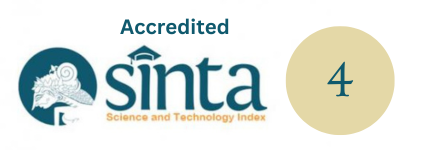Music Creation Garbebu | Tabuh Kreasi Garbebu
DOI:
https://doi.org/10.59997/jurnalsenikarawitan.v4i2.3437Keywords:
Karawitan, Tabuh Kreasi Pepanggulan, Gamelan Gong Kebyar, GarbebuAbstract
Garbebu's work is a work of musical art that was inspired when the creator saw directly the life events that occurred, namely the incident when a woman was married and carrying a baby in her stomach and seeing how a mother feels and waits to be able to experience pregnancy and have a baby. In other words, this work is inspired by the human life cycle. The human life cycle occurs by combining spermatozoid cells (Kama Petak) with ovarian cells (Kama Bang), which appear in the mother's womb. The process of unification or initial formation until the birth of a baby in a mother's womb is called Garbebu. The expression media used by the creator in expressing the idea of the work is the barungan gamelan Gong Kebyar, including Terompong, kendang cedugan, bebende, and kempli, which are the determining waits in pegongan (lelambatan) works which are still related to tabuh kreasi pepanggulan. This idea is expressed in an intertwining of tones in a musical work by processing musical elements, namely melody, rhythm, tempo, and dynamics, to create a harmonious order. Tabuh kreasi pepanggulan Garbebu uses the Tri Angga structure, which consists of Pengawit, Pengawak/pengadeng, and Pengecet, and the composition of the work is innovated with several parts that remain based on traditional standards. In realizing this Garbebu work, the creator used a creation method that refers to the book Panca Shtiti Ngawi Sani, written by Mr. I Wayan Dibia in 2020, which consists of the Inspiration Stage (Ngawirasa), Exploration Stage (Ngewacak), Conception Stage (Ngarencana), Stage Execution (Ngewangun), and Ngebah/maedeng Stage.
Downloads
References
Bandem, I. M. (1986). Prakempa, Sebuah Lontar Gamelan Bali (Trans.). ASTI Denpasar.
Bandem, I. M. (2013). Gamelan Bali di atas Panggung Sejarah. Badan Penerbit STIKOM Bali. https://books.google.co.id/books/about/Gamelan_Bali_di_atas_panggung_sejarah.html?id=_lLmoAEACAAJ&redir_esc=y
Dibia, I. W. (2020). Panca Sthiti Ngawi Sani: Metodologi Penciptaan Seni. Pusat Penerbitan LP2MPP Institut Seni Indonesia (ISI) Denpasar.
Hawkins, A. M., & Hadi, Y. S. (2003). Mencipta lewat tari (creating though dance) (Revisi). Mathili.
Kariasa, I. N., Wardizal, W., & Santosa, H. (2023). The creative process of creating dance accompaniment gendhing Murdanata Dedarining Aringgit: the mascot dance of Nagasepaha Village in Buleleng Regency, Bali. Dewa Ruci: Jurnal Pengkajian Dan Penciptaan Seni, 18(2), 146–158. https://doi.org/10.33153/dewaruci.v18i2.4904
Pradana, K. A. W., & Garwa, I. K. (2021). Samirata a Musical Art Composition Creative Percussion | Samirata: Sebuah Karya Komposisi Seni Karawitan Tabuh Kreasi. Ghurnita: Jurnal Seni Karawitan, 01(03), 145–151. https://doi.org/https://doi.org/10.59997/jurnalsenikarawitan.v1i3.355
Praditya, D., Saptono, S., & Partha, I. K. (2023). Creation Music Pepanggulan Ki Gepang | Tabuh Kreasi Pepanggulan, “Ki Gepang.” GHURNITA: Jurnal Seni Karawitan, 1(4), 264–272. https://doi.org/10.59997/jurnalsenikarawitan.v1i4.427
Pramana, I. P. R. B., Hendra, S., Saptono, Yudarta, I. G., & Sutirtha, I. W. (2023). Unpacking the Form and Structure of Jaya Baya Music Composition in JES Gamelan Fusion. Gondang: Jurnal Seni Budaya, 7(2), 338–351. https://doi.org/https://doi.org/10.24114/gondang.v6i2.49581
Pryatna, I. P. D. H. S. (2020). Konsep Musikal Instrumen kendang Dalam Gamelan Gong Kebyar Bali. Resital: Jurnal Seni Pertunjukan, 21(2), 73–84. https://doi.org/10.24821/resital.v21i2.4220
Pryatna, I. P. D., Santosa, H., & Sudirga, I. K. (2020). Permainan Kendang Bali. Dewa Ruci: Jurnal Pengkajian Dan Penciptaan Seni, 15(2), 90–100. https://doi.org/10.33153/dewaruci.v15i2.2991
Putra, I. G. A. M. D. (2004). Panca Yadnya. Milik Pemerintah Provinsi Bali Kegiatan Peningkatan Sarana Prasarana Kehidupan Beragama.
Putu Danendra adi Bagaskara, B., Saptono, S., & Partha, I. K. (2024). Music Creation Durmanggala | Tabuh Kreasi Durmanggala. GHURNITA: Jurnal Seni Karawitan, 4(1), 114–122. https://doi.org/10.59997/jurnalsenikarawitan.v4i1.3378
Santosa, H., Saptono, & Sutirtha, W. (2023). Tabuh Kreasi Karya I Nyoman Windha (Hendra Santosa (ed.)). Penerbit Adab. https://books.google.co.id/books?id=e83xEAAAQBAJ&pg=PA194&dq=tabuh+kreasi+karya+i+nyoman+windha&hl=en&newbks=1&newbks_redir=0&sa=X&ved=2ahUKEwjxpLOqxcyEAxXbbGwGHUsGA1oQ6AF6BAgLEAI#v=onepage&q=tabuh kreasi karya i nyoman windha&f=false
SemaraBawa, A., & Sudhana, I. K. (2023). Wisala Meru Musical Artwork | Karya Seni Musik Wisala Meru. GHURNITA: Jurnal Seni Karawitan, 1(3), 195. https://doi.org/10.59997/jurnalsenikarawitan.v1i3.394
Supriyadnyana, P. G. W., Mustika, P. G., & Muryana, K. (2020). Pengantar Karya Komposisi Tabuh Kreasi Pepanggulan Amande. Kalangwan: Jurnal Seni Pertunjukan, 6(1), 16–25.
Wicaksandita, I. D. K., Sariada, I. K., & Santosa, H. (2020). Estetika Adegan Bondres Wayang Tantri oleh Dalang I Wayan Wija. Panggung, 30(1), 17–34. https://doi.org/10.26742/panggung.v30i1.1146
Yudarta, I. G. (2023). Sosialisasi Pogram MBKM (Merdeka Belajar Kampus Merdeka). ISI Denpasar.








